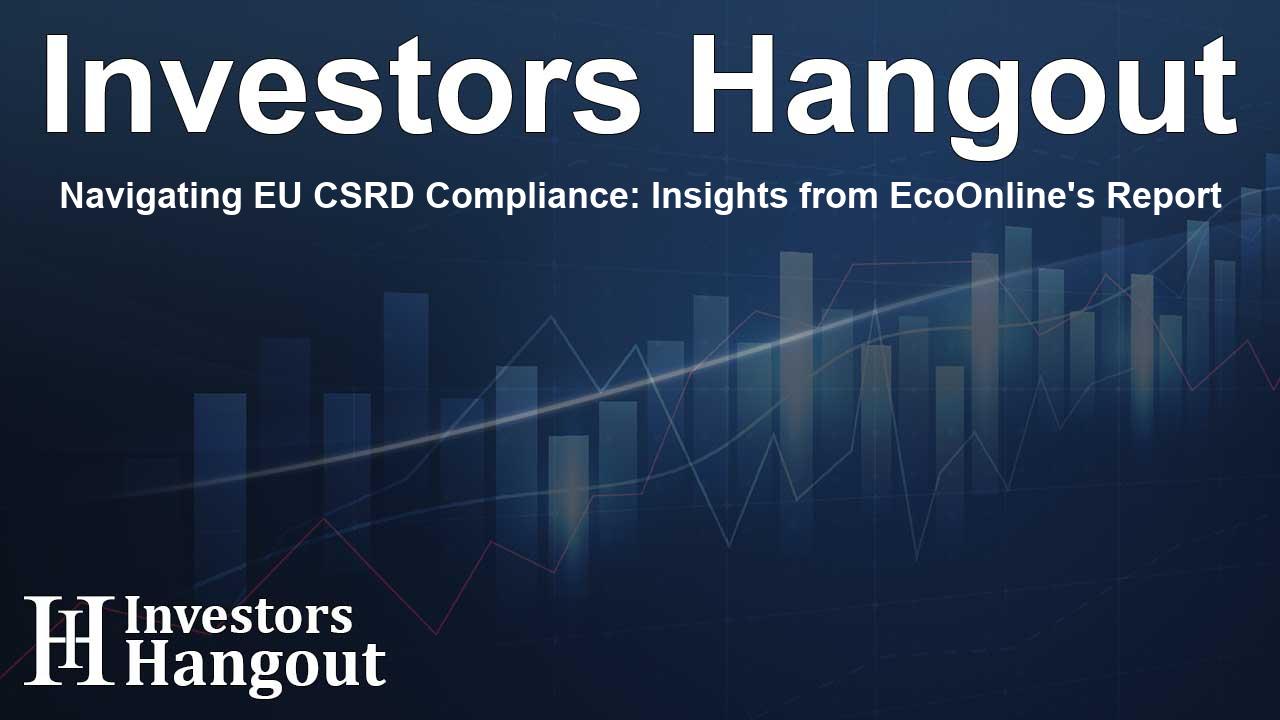Navigating EU CSRD Compliance: Insights from EcoOnline's Report

Understanding the Challenges of EU CSRD Compliance
Businesses are increasingly committing to sustainability, moving beyond mere compliance to fully integrate sustainable practices into their operations. Recent research from EcoOnline unveils the struggles of mid-market organizations in achieving readiness for the EU Corporate Sustainability Reporting Directive (CSRD).
Examining the Readiness Landscape
While a staggering 100% of businesses have initiated preparations for compliance with the EU CSRD, the degree of readiness varies significantly among different company sizes. EcoOnline’s latest report reveals that enterprise organizations with annual revenues exceeding €1 billion exhibit a higher level of preparedness compared to their mid-market counterparts. A noticeable 60% of enterprises feel they are 'almost ready.' In contrast, only 37% of mid-market companies express a similar sense of readiness, raising concerns about potential challenges they may face.
Mid-Market Concerns
The upcoming regulations provide mid-market organizations with a slightly extended preparation period; however, many still need additional support. Key areas highlighted by survey respondents include:
- Data collection
- Greenhouse gas (GHG) accounting
- Creation of EU CSRD report outputs
The insights indicate a pronounced lack of confidence among mid-market firms regarding their existing tools and processes.
Pathways to Achieving Readiness
More than half of the organizations surveyed regard double materiality assessments as a critical step in their journey toward compliance. EcoOnline's SVP of ESG & Sustainability, David Picton, emphasizes that while it's promising to see a focus on this area, companies need to accelerate their efforts. He states, "These assessments are only the first step in meeting complex compliance requirements; prompt action toward optimizing data collection and report drafting is essential to meet EU CSRD deadlines."
Strategies for Success
To enhance their preparedness, organizations have adopted various approaches, including:
- Leadership Commitment: An impressive 89% of organizations have established senior leadership roles dedicated to sustainability strategy.
- Seeking Expertise: Over 63% of organizations are pursuing consultancy support to improve data collection and reporting processes.
- Utilizing Technology: A significant 94% are looking to leverage third-party software for their reporting needs, while 76% are implementing tools specifically for data collection.
- Investing in Sustainability: With 95% planning to enhance their sustainability budgets in the coming years, many mid-market companies are eager to bolster their readiness efforts.
Embracing a Sustainable Future
An encouraging finding from the report indicates that a substantial majority of respondents—66% of enterprises and 89% of mid-market companies—believe the CSRD directive will facilitate meaningful sustainability integration within their operations over the next few years. Many companies are already embracing voluntary reporting frameworks, with 93% adopting the Science Based Targets Initiative and 99% engaging with the Global Reporting Initiative.
As Picton asserts, "Compliance is no longer enough; businesses must proactively invest in long-term sustainable practices to generate genuine impacts. The EU CSRD can catalyze this behavioral shift, but to realize lasting benefits, organizations must embed sustainability into their core operations."
Conclusion
EcoOnline’s findings serve as a clarion call for mid-market organizations striving to meet EU CSRD compliance. With appropriate strategies, investment in technology, and commitment from leadership, these businesses can successfully navigate the evolving landscape of sustainability regulations.
Frequently Asked Questions
What is the EU CSRD?
The EU Corporate Sustainability Reporting Directive (CSRD) is a regulation designed to enhance transparency and accountability regarding sustainability-related information from companies.
What challenges do mid-market organizations face in compliance?
Mid-market organizations often struggle with data collection, greenhouse gas accounting, and drafting necessary reports, leading to a sense of unpreparedness.
How can companies improve their compliance readiness?
Companies can enhance their readiness by obtaining external expertise, leveraging technology, and fostering a top-down commitment to sustainability.
Why is double materiality assessment important?
Double materiality assessments help organizations identify key areas for resource investment, ensuring they meet both regulatory and sustainability goals.
What future trends are expected with EU CSRD implementation?
Many organizations anticipate that the CSRD will drive more profound integration of sustainability practices, benefiting both operational efficiency and corporate reputation over time.
About The Author
Contact Dominic Sanders privately here. Or send an email with ATTN: Dominic Sanders as the subject to contact@investorshangout.com.
About Investors Hangout
Investors Hangout is a leading online stock forum for financial discussion and learning, offering a wide range of free tools and resources. It draws in traders of all levels, who exchange market knowledge, investigate trading tactics, and keep an eye on industry developments in real time. Featuring financial articles, stock message boards, quotes, charts, company profiles, and live news updates. Through cooperative learning and a wealth of informational resources, it helps users from novices creating their first portfolios to experts honing their techniques. Join Investors Hangout today: https://investorshangout.com/
The content of this article is based on factual, publicly available information and does not represent legal, financial, or investment advice. Investors Hangout does not offer financial advice, and the author is not a licensed financial advisor. Consult a qualified advisor before making any financial or investment decisions based on this article. This article should not be considered advice to purchase, sell, or hold any securities or other investments. If any of the material provided here is inaccurate, please contact us for corrections.
